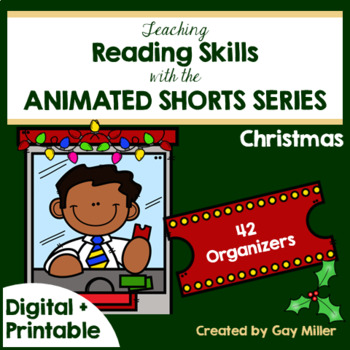Teaching Reading with Animated Short Films Christmas | Digital + Printable
- PDF
- Google Apps™
- Internet Activities

What educators are saying
Also included in
- If you are looking to add some high interest activities to your lessons, try using animated shorts to teach reading and writing skills. This packet contains graphic organizers covering many Common Core skills. The skills covered in Part 1 include the following.Inference and Drawing Conclusions SummPrice $10.80Original Price $18.00Save $7.20
- If you are looking to add some high interest activities to your lessons, try using animated shorts to teach reading and writing skills. This packet contains graphic organizers covering many Common Core skills. $Save$ when you purchase this mega bundle which includes all 6 units.Part 1 – READING ANDPrice $25.00Original Price $57.50Save $32.50
Description
If you are looking to add some high interest activities to your lessons this Christmas season, try using animated shorts to teach reading skills.
The unit includes 43 activities to use with 43 Christmas themed videos. All short films will be added to a webpage on Book Units Teacher for easy access. The link to this webpage will be included in the purchased product. This product includes both digital activities for Google Slides plus printables.
Free Samples are found in the preview.
This resource contains graphic organizers covering the following Common Core skills.
Literature
RL.1 – Inference/Drawing Conclusions/Prediction/Details
RL.2 – Summarizing/Paraphrasing/Main Idea and Supporting Details/Theme
RL.3 – Description of Characters and Setting/Character Change/Types of Conflict
RL.5 – Structural Elements/Problem and Solution/Cause and Effect/ Chronology/ Comparison
RL.7 – Visual and Multimedia Elements/Mood and Tone
RL.9 – Compare and Contrast
Informational Text
RI.6 – Comparing Accounts
Check other products in this series on Teachers Pay Teachers:
Part 1 - 52 Organizers
Teaching Reading Skills with Animated Shorts Pt 1 [Digital + Printable]
Teaching Reading Skills with Animated Shorts Pt 1 [Printable]
Part 2 - An Additional 52 Organizers
Teaching Reading Skills with Animated Shorts Pt 2 [Digital + Printable]
Teaching Reading Skills with Animated Shorts Pt 1 [Printable]
Animated Shorts Christmas
Teaching Reading Skills with Animated Shorts [Digital + Printable]
Teaching Reading Skills with Animated Shorts [Printable]
Writing Series
Three Unit Bundle for Narrative, Informative, and Opinion Writing
Narrative Writing
Teaching Narrative Writing Skills with Animated Short Films [Digital + Printable]
Informative Writing
Teaching Informative Writing Skills with Animated Shorts Digital + Printable
Opinion Writing
Teaching Opinion Writing Skills with Animated Shorts Digital + Printable







